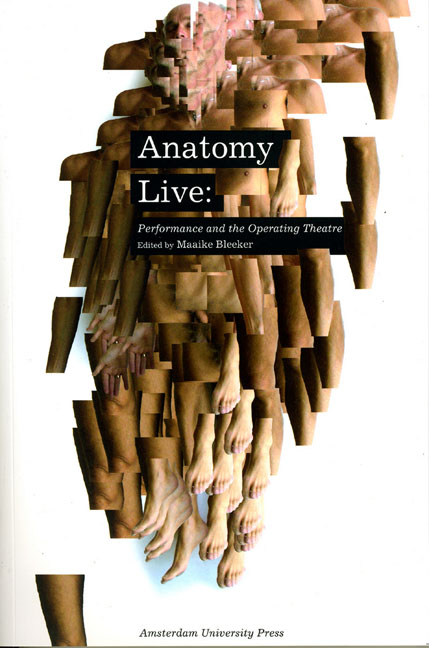Book contents
- Frontmatter
- Contents
- Acknowledgements
- Prologue - Men with Glass Bodies
- Introduction
- Performance Documentation 1: Holoman; Digital Cadaver
- Digital Cadavers and Virtual Dissection
- ‘Who Were You?’: The Visible and the Visceral
- Performance Documentation 2: Excavations: Fresh but Rotten
- The Anatomy Lesson of Professor Moxham
- ‘Be not Faithless But Believing’: Illusion and Doubt in the Anatomy Theatre
- Performance Documentation 3: De Anatomische Les
- Of Dissection and Technologies of Culture in Actor Training Programs – an Example from 1960s West Germany
- Ocular Anatomy, Chiasm, and Theatre Architecture as a Material Phenomenology in Early Modern Europe
- Performance Documentation 4: Camillo – Memo 4.0: The Cabinet of Memories – A Tear Donnor Session
- Martin, Massumi, and the Matrix
- Performance Documentation 5: Sensing Presence no 1: Performing a Hyperlink System
- ‘Where Are You Now?’: Locating the Body in Contemporary Performance
- Performance Documentation 6: Under My Skin
- Anatomies of Live Art
- Performance Documentation 7: Crash
- Restaging the Monstrous
- Delirium of the Flesh: ‘All the Dead Voices’ in the Space of the Now
- Performance Documentation 8: Körper
- Operating Theatres: Body-bits and a Post-apartheid Aesthetics
- Index
Introduction
Published online by Cambridge University Press: 10 February 2021
- Frontmatter
- Contents
- Acknowledgements
- Prologue - Men with Glass Bodies
- Introduction
- Performance Documentation 1: Holoman; Digital Cadaver
- Digital Cadavers and Virtual Dissection
- ‘Who Were You?’: The Visible and the Visceral
- Performance Documentation 2: Excavations: Fresh but Rotten
- The Anatomy Lesson of Professor Moxham
- ‘Be not Faithless But Believing’: Illusion and Doubt in the Anatomy Theatre
- Performance Documentation 3: De Anatomische Les
- Of Dissection and Technologies of Culture in Actor Training Programs – an Example from 1960s West Germany
- Ocular Anatomy, Chiasm, and Theatre Architecture as a Material Phenomenology in Early Modern Europe
- Performance Documentation 4: Camillo – Memo 4.0: The Cabinet of Memories – A Tear Donnor Session
- Martin, Massumi, and the Matrix
- Performance Documentation 5: Sensing Presence no 1: Performing a Hyperlink System
- ‘Where Are You Now?’: Locating the Body in Contemporary Performance
- Performance Documentation 6: Under My Skin
- Anatomies of Live Art
- Performance Documentation 7: Crash
- Restaging the Monstrous
- Delirium of the Flesh: ‘All the Dead Voices’ in the Space of the Now
- Performance Documentation 8: Körper
- Operating Theatres: Body-bits and a Post-apartheid Aesthetics
- Index
Summary
In his classic 1947 ethnography of New Caledonia, Do Kamo: Person and Myth in a Melanesian World, Maurice Leenhardt reports on a conversation between himself and an elderly indigenous philosopher regarding the impact of European civilization on the cosmocentric world of the Canaques. Leenhardt suggested that the Europeans had introduced the notion of ‘spirit’ to indigenous thought. His interlocutor did not agree and remarked that on the contrary, they have ‘always acted in accord with the spirit.’ What the Europeans brought to the Canaques was the notion of body (Csordas in Weiss & Haber, 1999, p. 143). Of course, the Canaques had already been bodies; they existed as bodily beings before and after their ‘discovery’ by Europeans. However, the character of this existence is what was altered by ‘discovery’, and it is that alteration that is at stake in the difference of opinion to which Leenhardt's text testifies.
When discussing Leenhardt 's observations, Thomas Csordas remarks that, for Leenhardt, the Canaque philosopher's remark is a startling pronouncement. It overturns a stereotypical presumption that the body is allied with nature, and that spirit belongs to the civilized. Quoting Leenhardt, Csordas interprets the philosopher's remark as follows:
[The body] had no existence of its own, nor specific name to distinguish it. It was only support. But henceforth the circumscription of the physical being is completed, making possible its objectification. The idea of a human body becomes explicit. The discovery leads forthwith to a discrimination between body and the mythic world. (Weiss & Haber, 1999, p. 143)
The Canaques became body through European intervention. It is only with the arrival of European civilization that ‘the human body becomes explicit’, which involved the objectification of the body. For Csordas, this implies that the very possibility of individuation, or the creation of the individual that we understand as the core of the ideological structure of Western culture, has as its condition of possibility a particular mode of inhabiting the world as a bodily being.
- Type
- Chapter
- Information
- Anatomy LivePerformance and the Operating Theatre, pp. 11 - 22Publisher: Amsterdam University PressPrint publication year: 2008



